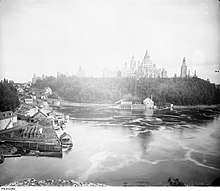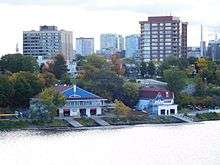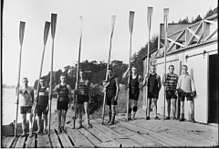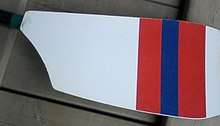Ottawa Rowing Club
The Ottawa Rowing Club (ORC) is a rowing club based in the City of Ottawa. It is the oldest rowing club in Canada and is located on the south banks of the Ottawa River at 10 Lady Grey Avenue. It is a registered club with Rowing Canada and Row Ontario.

 | |
| Location | Ottawa, Ontario |
|---|---|
| Founded | 1867 |
| Affiliations | Rowing Canada |
| Website | http://ottawarowingclub.com/ |

History
At the foot of Parliament Hill (1867–1896)
The Ottawa Rowing Club was founded on 6 June 1867,[1] the same year as the Canadian Confederation. One of its founders and first patron was Sir John A. Macdonald; other members of the first executive committee included Robert Lyon (politician), mayor of Ottawa, and; Allan Gilmour, businessman in the shipping and timber industries.
The original club house was a wooden building, initially built on pontoons, and moored to the shore of the Ottawa river at the foot of parliament hill, between the Rideau canal and the Chaudière falls (Akikodjiwan Falls under their Algonquin name). Whilst the view from the club house over the Chaudière falls was picturesque, the rowing conditions were difficult: vast field of sawdust and other refuse from an immense lumber mill situated about the falls, and logs escaping from the booms. Each spring, along with the melting ice, the club house floated downstream and came aground. Every year it was brought back up near the Rideau canal.
The club’s first-ever regatta, held on 26 September 1867[2], began with great promise: “The day was very fine, the weather having been all that could possibly be desired for comfort,” noted the news coverage. “Throughout the afternoon crowds of people lined the river banks to witness the sport, while the bosom of the river literally swarmed with all sorts of sailing craft, from the tiniest little shell up to the stateliest steamboat.” The event attracted competitors from Toronto, Hamilton and Quebec City, but in the showcase first event — a four-mile, open boat sailing race — local businessmen Edward McGillivray in Who’s Ahead and club secretary R.H. Haycock in Undine were even in the final stretch before Who’s Ahead answered its own question, winning by “about three lengths.” Despite the dramatic finish in the first of seven races, spectators grumbled that the regatta overall was a bore, with long delays between races. But “the start has been made,” Haycock wrote to the Ottawa Times in response to the complaints, and the club would “spare no trouble in endeavouring to improve upon this, the first attempt.”
In the early 1870s, the ORC ceased to exist before being re-introduced on 25 June 1875 with approximately 100 members.[3]
In 1884 and 1885, the club house suffered important damage when it sank. Members of the Ottawa Rowing Club, led by P. D. Ross, discussed building a permanent foundation for the club boat house in 1887.[4] In 1891, P.D. Ross, executive committee member of the Canadian Association of Amateur Oarsmen declined hosting the association's regatta due to the bad course on the Ottawa river and unsatisfactory financial condition of the Ottawa Rowing Club[5].
On Lady Grey Drive (1896–present)

In spring 1896, the members of the Club decided to purchase a piece of the river front property at 10 Lady Grey Drive and leave the club house in its current, permanent location. The club is just west of and below Sir John A. Macdonald's home Earnscliffe that is now the residence of the Britain's High Commissioner to Canada.
For six consecutive years, from 1905 to 1911, members of the club were the North American champions.[6] The two world wars were difficult years for the club, with fourteen members of the club losing their lives while serving during World War I[7] and with the shell house being neglected and showing signs of deterioration.
During the Depression years, P.D. Ross, former editor of the defunct Ottawa Journal, was president of the club. He infuriated his reporters by paying them small salaries while openly spending into equipment and upkeep for the rowing club.[8]
In 1949, the Ottawa Rowing Club accepted to contribute to the development of the rowing program at the University of Ottawa by offering equipment and coaches.[9] However, the 1950s and 1960s was a period of decline for the Ottawa Rowing Club. After seizing Club due to financial constraints, the City of Ottawa agreed to restore in 1967 the part of the old shell house that exists today but decided to demolish the other half of the building due to its poor condition (that portion of the building stored boats and included a ballroom).[10] On that year, there were only nine members of the Club and the permanent closure of the club was being debated.[11]
Volunteers, such as Peter King, supported the development of rowing in Ottawa in the 1970s. The rowing boom resulted in two new clubs (that do not exist anymore): the Nepean Rowing Club and the Ottawa Carleton Rowing School.
With close to 1000 members, the Ottawa Rowing Club is one of the largest clubs in Canada.
Facilities
The Ottawa Rowing Club rows on the Ottawa river (Kitchissippi under its Algonquin name). The rowers launch racing shells with bow pointing westward upstream, and effectuate a loop from the Alexandra Bridge to the Rockcliffe Airport, rowing downstream on the Quebec side and upstream on the Ontario side. The full loop is approximately 12 kilometres.

The ORC facilities includes two main buildings. The older building (est. 1896) houses members’ privately owned skiff on the ground floor. The second floor is an interpretation centre that also serves as banquet facilities rented out for weddings and other conventions. The building was renovated in 1999 by the City of Ottawa.
The second shell house was built in 1987. It consists of a two-story building with four bays for shell and oar storage on the ground floor.[12] Administrative offices, change rooms, and ergometers and weight room are located on the second floor.
Notable rowers
In addition to winning four times the Stanley Cup with the Ottawa Hockey Club and being a member of the Hockey Hall of Fame, Harvey Pulford was a member of the 1910 Ottawa Rowing Club eight that defeated every one of its opponents, earning the Canadian and North American championships. Pulford later became president of the Ottawa Rowing Club. He served as president of Ottawa Rowing Club until resigning in 1936.
The 1910 crew

In 1908 two four-man crews won numerous Canadian and American championships. These two crews were joined into a new shell in 1910: the "Bagnall", christened to the name of the person who provided the funds to purchase the boat. The eight won the 1910 Royal Canadian Henley Regatta and first holder of the Ned Hanlan Memorial Trophy. Within 24 hour of the victory, Ottawa citizens raised funds to bring the crew to the National Association Regatta in Washington, D.C. where the Ottawa crew won again.[13] The eight crew, but also a four-men crew, later competed at the Grand Challenge Cup of the Henley Royal Regatta where they finished second behind the Magdalen College of Oxford.[14] The coach of the 1910 crew was Jan A. Ten Eyck who captured ten U.S. National Championships as the coach for Syracuse University.
The crew was made of the following persons represented from left to right on the adjacent picture: Harvey Pulford (stroke), Eddie Philips (7-seat), Bill Harrison (6-seat), Bob Greene (5-seat), Jim McCuaig (4-seat), Marty Kilt (3-seat), Thayer Jolliffe (2-seat), Felix Sowden (bow-seat), and Chester Payne (coxswain).[15]
The 1948 Olympians
After World War II, the Club regrouped and produced impressive results in the form of the double scull boat of Ted Graves and Gabriel Beaudry who won the 1948 North American Championships and represented Canada at the London Olympic Games on that same year.
Gabriel Beaudry undertook numerous athletic pursuits and, indeed, in his youth he was not only a North American and European rowing champion, but also excelled in college football, which helped him pay for his education at the University of Ottawa. It was not until he was nearly 40 that he began to pursue skiing, after a trip to Whistler, British Columbia, years before it became a popular ski venue and he became one of several leading figures of his generation to help develop the site and the sport. For a time, he became director of the Canadian Ski Association, which later became Alpine Canada.[16]
As for Ted Graves, his Olympic participation came after serving under the Royal Canadian Air Forces during World War II (415 Squadron Bomber Command[17]) and being a prisoner of war.[18]
Participation in international events
Hereafter is a list of athletes born in Ottawa or have rowed with the Ottawa Rowing Club and have participated in international events.
Participation in the Olympic Games:
| Name | Olympic year | Game location | Event |
|---|---|---|---|
| Athol Meech | 1928 | Amsterdam | 8+ (bronze medal) |
| Gabriel Beaudry | 1948 | London | 2x |
| Fred Graves | 1948 | London | 2x |
| James Walker | 1972 | Munich | 4+ |
| Mike Neary | 1972 | Munich | 2+ |
| Mike Neary | 1976 | Montréal | 2- |
| Beverley Cameron | 1976 | Montréal | 2x |
| Vicki Harber | 1984 | Los Angeles | 4x+ |
| Jeff Lay | 1996 | Atlanta | 4- lightweight (silver medal) |
| Alison Korn | 1996 | Atlanta | 8+ (silver medal) |
| Alison Korn | 2000 | Sydney | 8+ (bronze medal) |
| Morgan Jarvis | 2012 | London | 2x lightweight |
| David Blair | 2012 | London | 4+ mixed legs, trunk and arms |
| Cristy Nurse | 2016 | Rio de Janeiro | 8+ |
| Andrew Todd | 2016 | Rio de Janeiro | 4+ mixed legs, trunk and arms (bronze medal) |
Participation to the World Rowing Championships:
| Name | Championship year | Event Location | Event |
|---|---|---|---|
| Paul Amesbury | 2008 | Linz | LM8+ |
| Katharine Goodfellow | 2014 | Amsterdam | 4x |
| Cristy Nurse | 2014 | Amsterdam | 8+ (silver) |
| Katharine Goodfellow | 2015 | Aiguebelette | 2x |
| Cristy Nurse | 2015 | Aiguebelette | 8+ (bronze) |
| Cristy Nurse | 2015 | Aiguebelette | 2- |
| Andrew Todd | 2015 | Aiguebelette | 4+ mixed legs, trunk and arms |
| Jenna Pelham | 2016 | Rotterdam | 4x lightweight |
Participation to the World University Rowing Championships:
| Name | Championship year | Event location | Event |
|---|---|---|---|
| Paul Amesbury | 2006 | Trakai | 4- lightweight |
| Liliane Pagé | 2014 | Gravelines | 2x lightweight |
| Jenna Pelham | 2014 | Gravelines | 2x lightweight |
| Marika Kay | 2014 | Gravelines | 4+ |
| Alanna Forgarty | 2016 | Poznan | 2x lightweight |
| Zak Lewis | 2016 | Poznan | 4- |
Participation to the U23 World Championships:
| Name | Championship year | Event location | Event |
|---|---|---|---|
| Paul Amesbury | 2004 | Poznan | 4- lightweight (bronze) |
| Matthew Christie | 2013 | Linz | 1x lightweight |
| Dylan Harris | 2013 | Linz | 2x lightweight |
Four rowers on the 2016 edition of the Canadian national team have rowed with the Ottawa rowing Club: Kate Goodfellow, Sarah Black, Carolyn Ganes, Cristy Nurse, and Rosie Deboef.
Regattas
The ORC participated to the first regattas organized by the Canadian Association of Amateur Oarsmen, starting in 1880. In the late 19th century, the ORC held two sets of regattas per year, one in the spring confined to four-oared crews, and one in the fall.
Currently, the ORC hosts three regattas during the rowing season. The first one is the National Capital High School Regatta which takes place each year at the end of May/beginning of June on the Ottawa River.
The second race event is the P.D. Ross Memorial Regatta which first took place on 23 September 1950 on the Ottawa River between the University of Ottawa and McMaster University. From 1957 to 1972, the P.D. Ross Memorial trophy was awarded to the winner of the Club Eight (8+) event. Since 1998, the annual race is now between mixed women and men’s varsity and alumni crews from University of Ottawa and Carleton University either on the Rideau Canal or the Ottawa River.
The third race is Head of the Rideau (distance of 5 km) which is held at the end of September on the Rideau River. At its first edition in 1972, Head of the Rideau was raced on the Rideau canal.
Members of the club are also invited to participate in these different regattas throughout the year, in function of their membership and abilities.
- RADAR - Welland
- ERA High School Regatta - Montreal
- Canadian Secondary School High School Regatta - St Catharines
- Independence Day Regatta - Philadelphia
- ERA Regatta - Montreal
- RowOntario - Welland
- Royal Canadian Henley Regatta - St Catharines
- Head of the Trent - Peterborough
- Brock Invitational - St. Catharines
- Head of the Charles - Boston
- Ontario Universities Rowing Championship - St Catharines
- Head of the Fish - Saratoga Springs, NY
- Canadian Universities Rowing Championship
- RADAR - Welland
Club's colours
The colours of the Club are Navy Blue diagonal stripe with Cardinal Red background. In 1887, the Club’s uniform consisted of a Navy Blue jacket, trimmed with Cardinal Red, white flannel trousers, and a white guernsey, trimmed with the club colours; and a Navy Blue cap with Cardinal Red bars, or a straw hat with the club colours and Navy Blue and Cardinal Red stripped stockings.[19]


Membership
The Ottawa Rowing Club offers different memberships:
- Competitive
- Masters
- High School
- University
- Recreational
- Adult rowing league
- Learn to row
- Summer Youth Camps
References
- Ottawa Times, 6 June 1867.
- Ottawa Citizen, 30 June 2017
- A History of American Amateur Athletics and Aquatics, 1888.
- Ottawa Daily Citizen, 20 October 1887.
- The Toronto Daily Mail - 27 April 1891
- Greene, Trevor. 1988. Glory days. Ottawa Magazine, pp: 13–14.
- Ottawa Citizen. 13 November 1918.
- Greene, Trevor. 1988. Glory days. Ottawa Magazine, pp: 13–14.
- Archives of the University of Ottawa
- Information gathered from Wes Curran, umpire and rower at the Ottawa Rowing Club. July 2017.
- Ottawa Citizen Newspaper. 24 July 1986.
- Ottawa Citizen Newspaper. 14 October 1983.
- California Digital Newspaper Collection. Article from Los Angeles Herald, Volume 37, Number 317, 14 August 1910.
- Ottawa Citizen newspaper, 28 April 1953
- Ottawa Citizen newspaper, 28 April 1953
- Sports Reference
- 415 Squadron Association
- Ottawa Citizen, Obituaries. 21 February 2009
- 1878 by-laws and rules of the Ottawa Rowing Club